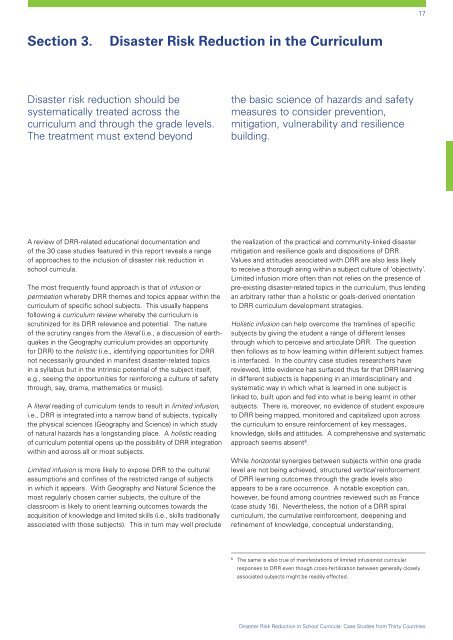Disaster Risk Reduction in School Curricula: Case Studies ... - Unicef
Disaster Risk Reduction in School Curricula: Case Studies ... - Unicef
Disaster Risk Reduction in School Curricula: Case Studies ... - Unicef
Create successful ePaper yourself
Turn your PDF publications into a flip-book with our unique Google optimized e-Paper software.
17<br />
Section 3.<br />
<strong>Disaster</strong> <strong>Risk</strong> <strong>Reduction</strong> <strong>in</strong> the Curriculum<br />
<strong>Disaster</strong> risk reduction should be<br />
systematically treated across the<br />
curriculum and through the grade levels.<br />
The treatment must extend beyond<br />
the basic science of hazards and safety<br />
measures to consider prevention,<br />
mitigation, vulnerability and resilience<br />
build<strong>in</strong>g.<br />
A review of DRR-related educational documentation and<br />
of the 30 case studies featured <strong>in</strong> this report reveals a range<br />
of approaches to the <strong>in</strong>clusion of disaster risk reduction <strong>in</strong><br />
school curricula.<br />
The most frequently found approach is that of <strong>in</strong>fusion or<br />
permeation whereby DRR themes and topics appear with<strong>in</strong> the<br />
curriculum of specific school subjects. This usually happens<br />
follow<strong>in</strong>g a curriculum review whereby the curriculum is<br />
scrut<strong>in</strong>ized for its DRR relevance and potential. The nature<br />
of the scrut<strong>in</strong>y ranges from the literal (i.e., a discussion of earthquakes<br />
<strong>in</strong> the Geography curriculum provides an opportunity<br />
for DRR) to the holistic (i.e., identify<strong>in</strong>g opportunities for DRR<br />
not necessarily grounded <strong>in</strong> manifest disaster-related topics<br />
<strong>in</strong> a syllabus but <strong>in</strong> the <strong>in</strong>tr<strong>in</strong>sic potential of the subject itself,<br />
e.g., see<strong>in</strong>g the opportunities for re<strong>in</strong>forc<strong>in</strong>g a culture of safety<br />
through, say, drama, mathematics or music).<br />
A literal read<strong>in</strong>g of curriculum tends to result <strong>in</strong> limited <strong>in</strong>fusion,<br />
i.e., DRR is <strong>in</strong>tegrated <strong>in</strong>to a narrow band of subjects, typically<br />
the physical sciences (Geography and Science) <strong>in</strong> which study<br />
of natural hazards has a longstand<strong>in</strong>g place. A holistic read<strong>in</strong>g<br />
of curriculum potential opens up the possibility of DRR <strong>in</strong>tegration<br />
with<strong>in</strong> and across all or most subjects.<br />
Limited <strong>in</strong>fusion is more likely to expose DRR to the cultural<br />
assumptions and conf<strong>in</strong>es of the restricted range of subjects<br />
<strong>in</strong> which it appears. With Geography and Natural Science the<br />
most regularly chosen carrier subjects, the culture of the<br />
classroom is likely to orient learn<strong>in</strong>g outcomes towards the<br />
acquisition of knowledge and limited skills (i.e., skills traditionally<br />
associated with those subjects). This <strong>in</strong> turn may well preclude<br />
the realization of the practical and community-l<strong>in</strong>ked disaster<br />
mitigation and resilience goals and dispositions of DRR.<br />
Values and attitudes associated with DRR are also less likely<br />
to receive a thorough air<strong>in</strong>g with<strong>in</strong> a subject culture of ‘objectivity’.<br />
Limited <strong>in</strong>fusion more often than not relies on the presence of<br />
pre-exist<strong>in</strong>g disaster-related topics <strong>in</strong> the curriculum, thus lend<strong>in</strong>g<br />
an arbitrary rather than a holistic or goals-derived orientation<br />
to DRR curriculum development strategies.<br />
Holistic <strong>in</strong>fusion can help overcome the traml<strong>in</strong>es of specific<br />
subjects by giv<strong>in</strong>g the student a range of different lenses<br />
through which to perceive and articulate DRR. The question<br />
then follows as to how learn<strong>in</strong>g with<strong>in</strong> different subject frames<br />
is <strong>in</strong>terfaced. In the country case studies researchers have<br />
reviewed, little evidence has surfaced thus far that DRR learn<strong>in</strong>g<br />
<strong>in</strong> different subjects is happen<strong>in</strong>g <strong>in</strong> an <strong>in</strong>terdiscipl<strong>in</strong>ary and<br />
systematic way <strong>in</strong> which what is learned <strong>in</strong> one subject is<br />
l<strong>in</strong>ked to, built upon and fed <strong>in</strong>to what is be<strong>in</strong>g learnt <strong>in</strong> other<br />
subjects. There is, moreover, no evidence of student exposure<br />
to DRR be<strong>in</strong>g mapped, monitored and capitalized upon across<br />
the curriculum to ensure re<strong>in</strong>forcement of key messages,<br />
knowledge, skills and attitudes. A comprehensive and systematic<br />
approach seems absent 5 .<br />
While horizontal synergies between subjects with<strong>in</strong> one grade<br />
level are not be<strong>in</strong>g achieved, structured vertical re<strong>in</strong>forcement<br />
of DRR learn<strong>in</strong>g outcomes through the grade levels also<br />
appears to be a rare occurrence. A notable exception can,<br />
however, be found among countries reviewed such as France<br />
(case study 16). Nevertheless, the notion of a DRR spiral<br />
curriculum, the cumulative re<strong>in</strong>forcement, deepen<strong>in</strong>g and<br />
ref<strong>in</strong>ement of knowledge, conceptual understand<strong>in</strong>g,<br />
5<br />
The same is also true of manifestations of limited <strong>in</strong>fusionist curricular<br />
responses to DRR even though cross-fertilization between generally closely<br />
associated subjects might be readily effected.<br />
<strong>Disaster</strong> <strong>Risk</strong> <strong>Reduction</strong> <strong>in</strong> <strong>School</strong> <strong>Curricula</strong>: <strong>Case</strong> <strong>Studies</strong> from Thirty Countries

















